Enhancing Heating Performance of Low-Temperature Air Source Heat Pumps Using Compressor Casing Thermal Storage
Abstract
:1. Introduction
2. Operating Principle of DE-CCTS
3. Experimental Apparatus and Method
3.1. Experimental Apparatus
3.1.1. DE-CCTS Device
3.1.2. Measuring Instrument and Measuring Point Layout
3.2. Experimental Method
3.2.1. On-Time Mode of DE-CCTS and Performance Comparison
3.2.2. Uncertainty Analysis COP Value
4. Results and Discussion
4.1. Thermal Storage PCM
4.2. On-Time Mode of DE-CCTS under Different Ambient Temperatures
4.3. Summary of the Law of on-Time Mode
4.4. Performance Comparison between Original System and DE-CCTS
5. Conclusions
- (1)
- The proposed DE-CCTS uses thermal storage PCM, which is filled in the secondary evaporator, to recover the waste heat of the compressor casing. The waste heat of the compressor casing is considered a high-temperature ambient environment of the secondary evaporator. It increases the suction temperature and decreases the discharge temperature, especially at low temperatures.
- (2)
- Relative to the original system under different ambient temperatures, the proposed DE-CCTS shows a 0.1–1°C increase in suction temperature, a 0.1–0.5 °C decrease in discharge temperature, and 0.85–4.72% increase in the COP. These effects are especially evident at low temperatures.
Author Contributions
Funding
Acknowledgments
Conflicts of Interest
References
- Zhang, L.; Jiang, Y.; Dong, J.; Yao, Y. Advances in vapor compression air source heat pump system in cold regions: A review. Renew. Sustain. Energy Rev. 2018, 8, 353–365. [Google Scholar] [CrossRef]
- Zheng, N.; Song, W.; Zhao, L. Theoretical and experimental investigations on the changing regularity of the extreme point of the temperature difference between zeotropic mixtures and heat transfer fluid. Energy 2013, 55, 541–552. [Google Scholar] [CrossRef]
- Zhang, Q.; Zhang, L.; Nie, J.; Li, Y. Techno-economic analysis of air source heat pump applied for space heating in northern China. Appl. Energy 2017, 207, 533–542. [Google Scholar] [CrossRef]
- Chen, J.; Havtun, H.; Palm, B. Conventional and advanced exergy analysis of an ejector refrigeration system. Appl. Energy 2015, 144, 139–151. [Google Scholar] [CrossRef]
- Kelly, J.A.; Fu, M.; Clinch, J.P. Residential home heating: The potential for air source heat pump technologies as an alternative to solid and liquid fuels. Energy Policy 2016, 98, 431–442. [Google Scholar] [CrossRef] [Green Version]
- Wang, B.; Ding, Y.; Shi, W. Experimental research on vapor-injected rotary compressor through end-plate injection structure with check valve. Int. J. Refrig. 2018, 96, 131–138. [Google Scholar] [CrossRef]
- Chen, J.; Yu, J. Energy and exergy analysis of a new direct-expansion solar assisted vapor injection heat pump cycle with subcooler for water heater. Sol. Energy 2018, 171, 613–620. [Google Scholar] [CrossRef]
- Xu, S.; Niu, J.; Cui, Z.; Ma, G. Experimental research on vapor-injected heat pump using injection subcooling. Appl. Therm. Eng. 2018, 136, 674–681. [Google Scholar] [CrossRef]
- Qi, H.; Liu, F.; Yu, J. Performance analysis of a novel hybrid vapor injection cycle with subcooler and flash tank for air-source heat pumps. Int. J. Refrig. 2017, 74, 540–549. [Google Scholar] [CrossRef]
- Wang, X.; Yu, J.; Xing, M. Performance analysis of a new ejector enhanced vapor injection heat pump cycle. Energy Convers. Manag. 2015, 100, 242–248. [Google Scholar] [CrossRef]
- Ooi, K.T.; Wong, T.N. A computer simulation of a rotary compressor for household refrigerators. Appl. Therm. Eng. 1997, 17, 65–78. [Google Scholar] [CrossRef]
- Park, Y.C. Transient analysis of a variable speed rotary compressor. Energy Convers. Manag. 2010, 51, 277–287. [Google Scholar] [CrossRef]
- Liu, Z.; Lou, F.; Qi, X.; Zhao, B.; Yan, J.; Shen, Y. Performance study of constant temperature water immersion thawing system using refrigerator compressor casing heat. Int. J. Energy Res. 2019, 1–12. [Google Scholar] [CrossRef]
- Liu, Z.; Fan, P.; Wang, Q.; Chi, Y.; Zhao, Z.; Chi, Y. Air source heat pump with water heater based on a bypass-cycle defrosting system using compressor casing thermal storage. Appl. Therm. Eng. 2018, 128, 1420–1429. [Google Scholar] [CrossRef]
- Liu, Z.; Zhao, F.; Zhang, L.; Zhang, R.; Yuan, M.; Chi, Y. Performance of bypass cycle defrosting system using compressor casing thermal storage for air-cooled household refrigerators. Appl. Therm. Eng. 2018, 130, 1215–1223. [Google Scholar] [CrossRef]
- Zhang, L.; Dong, J.; Jiang, Y.; Yao, Y. A novel defrosting method using heat energy dissipated by the compressor of an air source heat pump. Appl. Energy 2014, 133, 101–111. [Google Scholar]
- Huang, B.; Jian, Q.; Luo, L.; Zhao, J. Experimental study of enhancing heating performance of the air-source heat pump by using a novel heat recovery device designed for reusing the energy of the compressor shell. Energy Convers. Manag. 2017, 138, 38–44. [Google Scholar] [CrossRef]
- China National Standardization Management Committee. Low Ambient Temperature Air Source Heat Pump (Water Chilling) Packages—Part 2: Heat Pump (Water Chilling) Packages for Household and Similar Application; GB/T 25127.2-2010; China Standards Press: Shenzhen, China, 2010. (In Chinese) [Google Scholar]
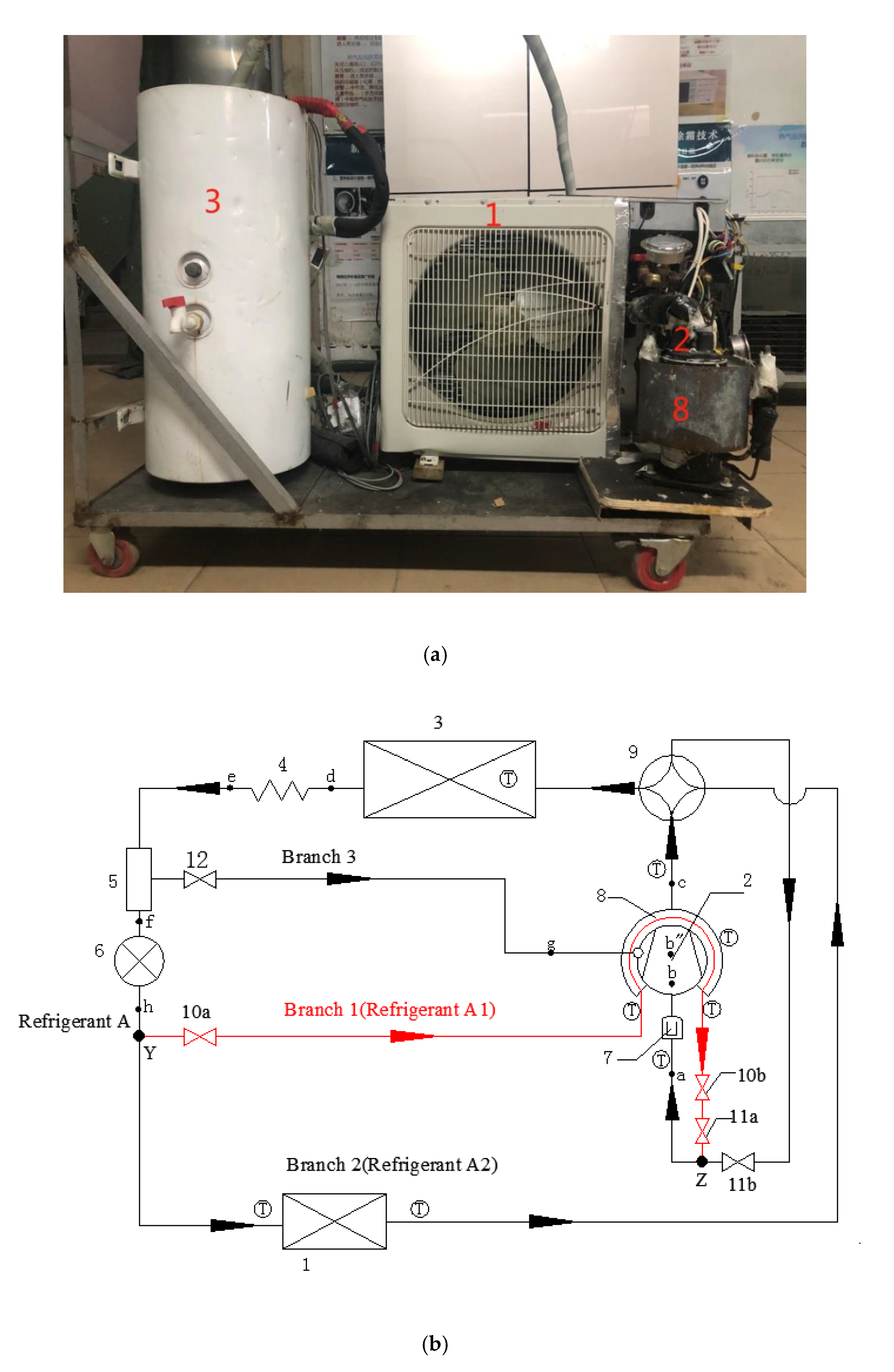


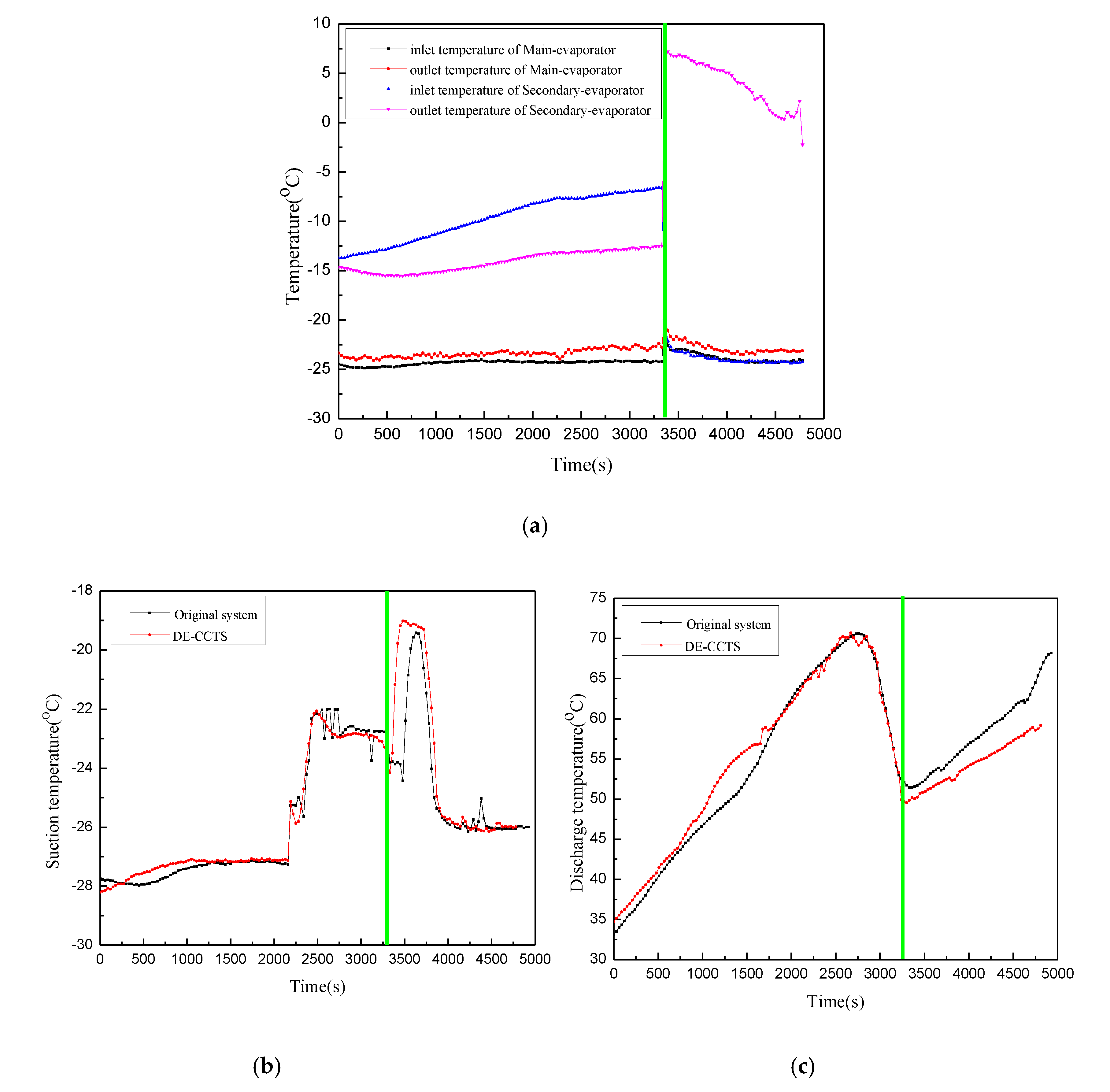

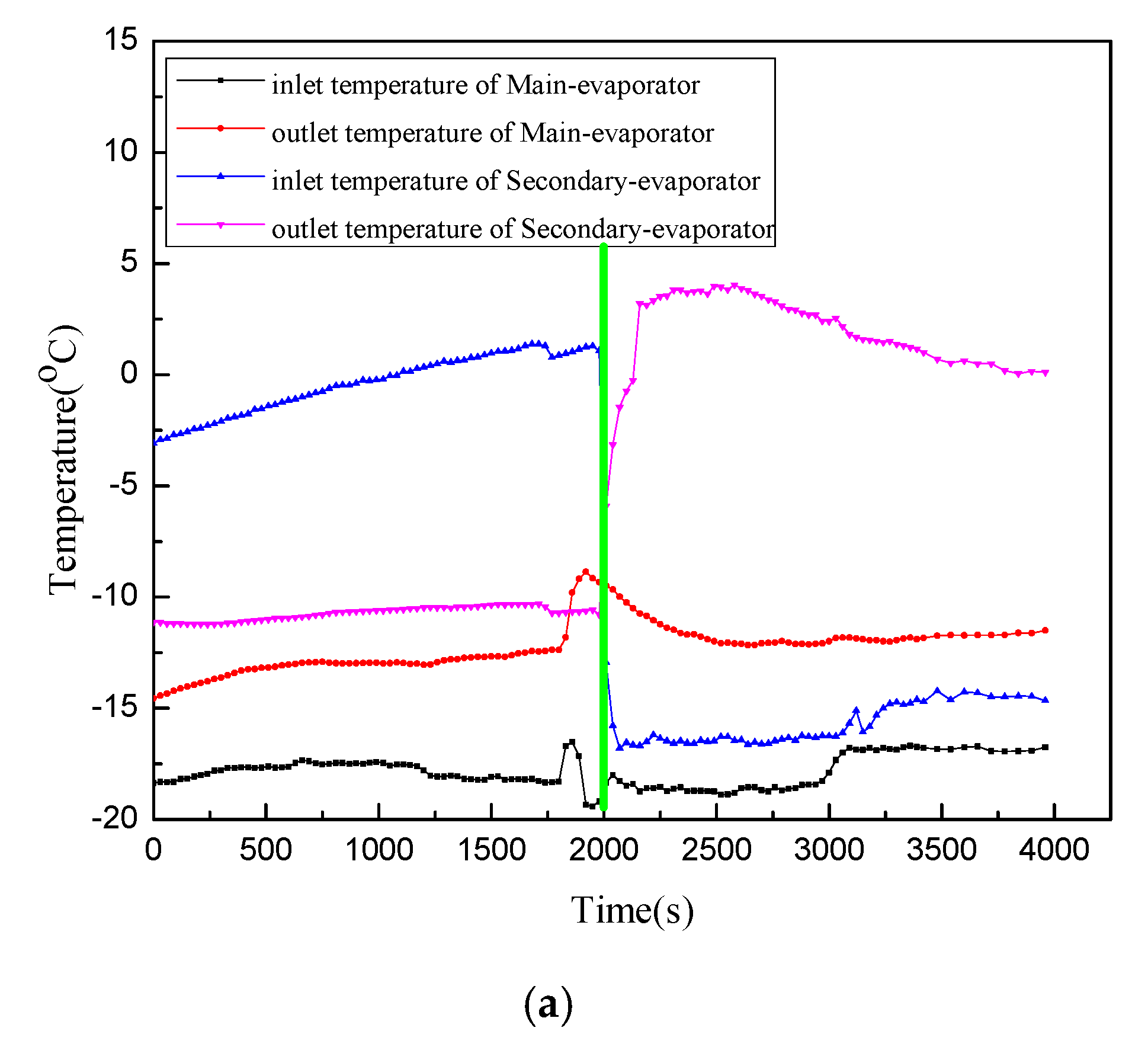
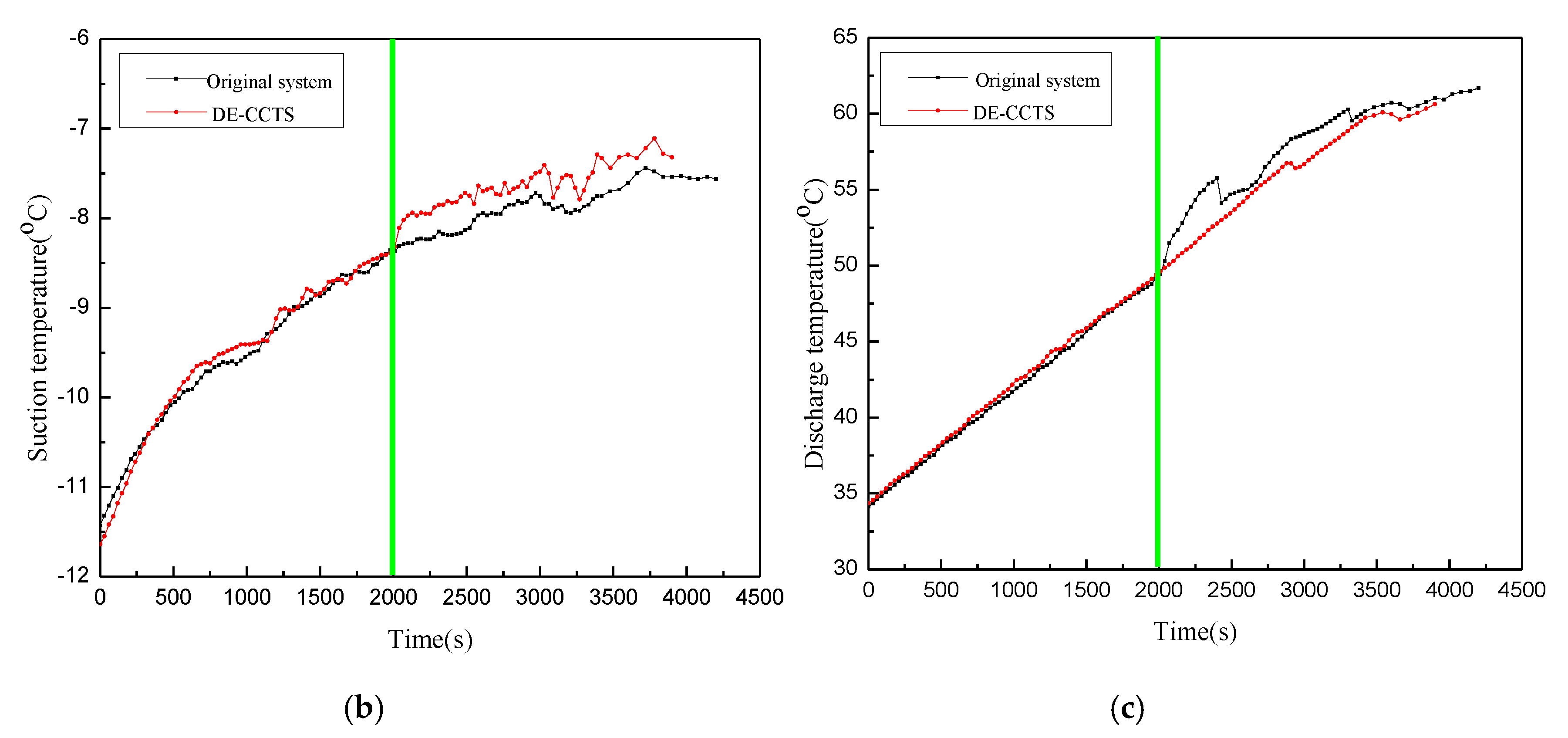
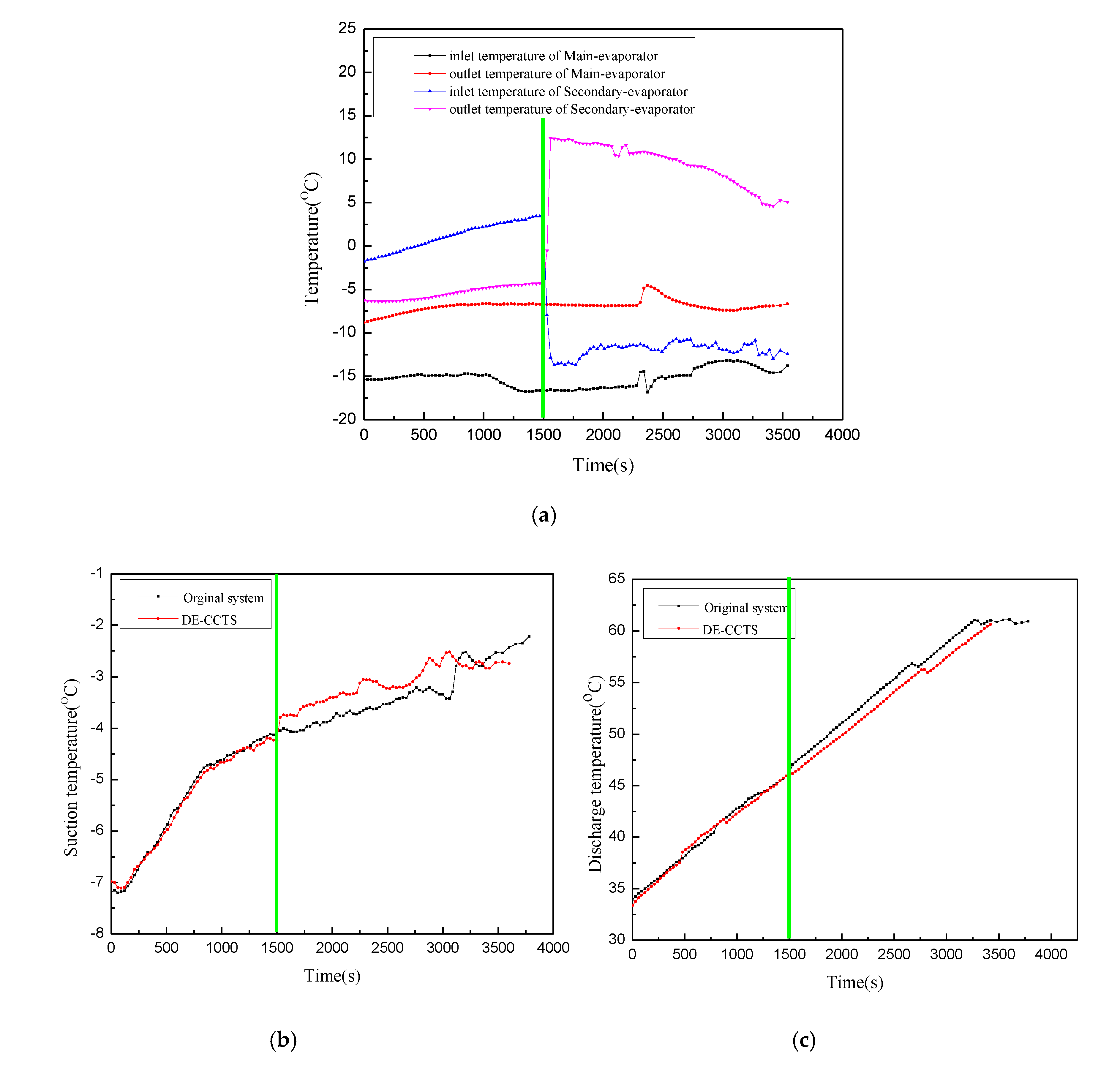
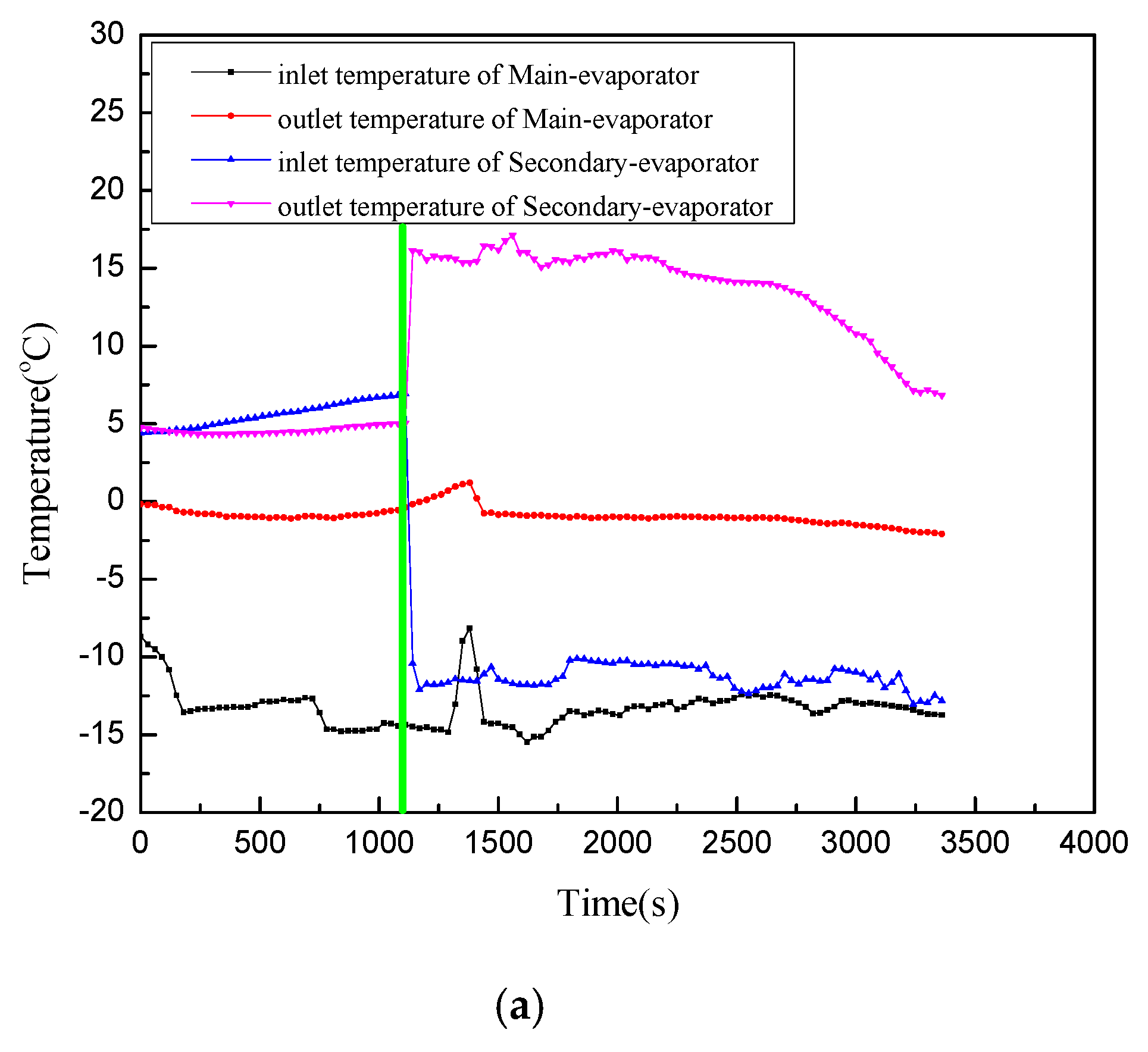
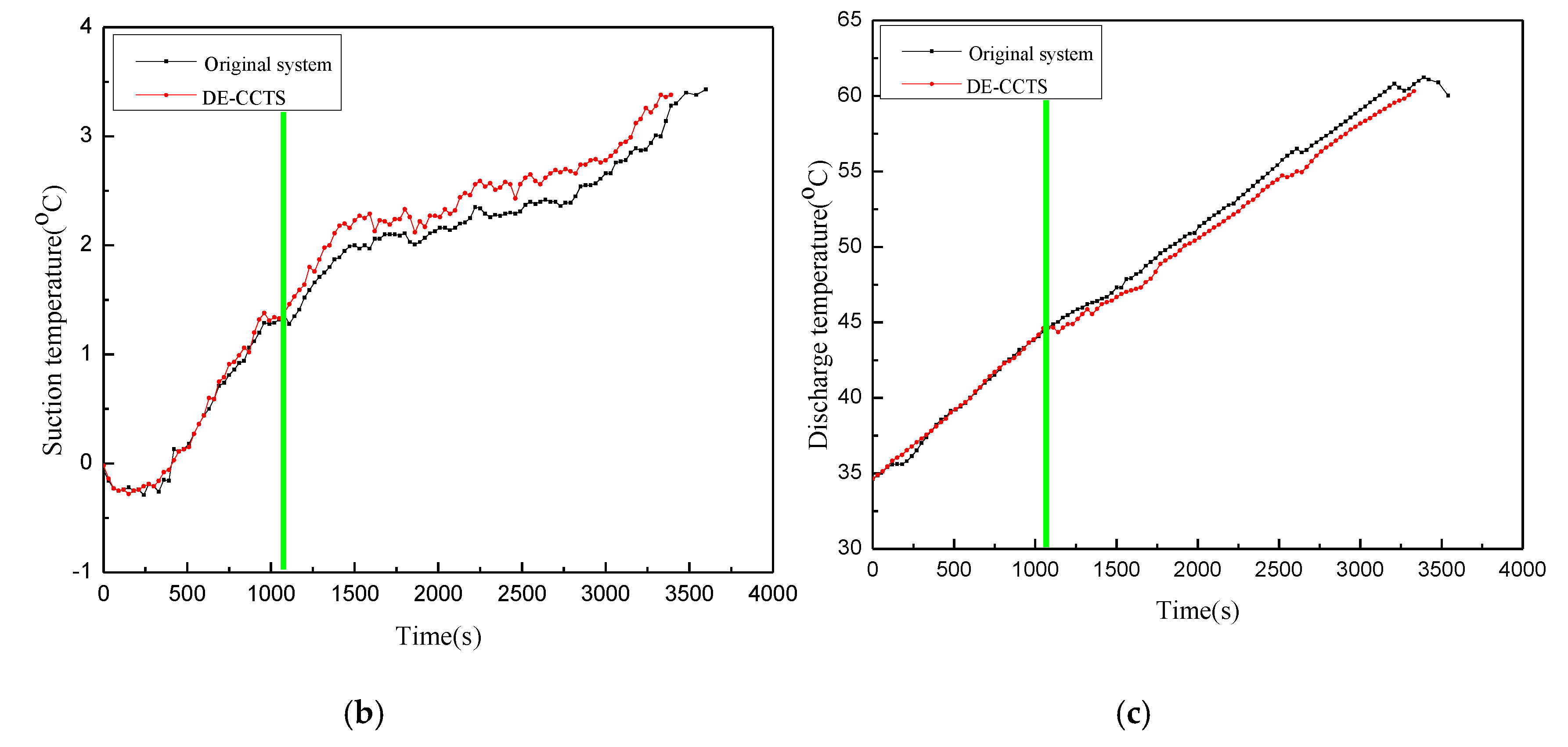

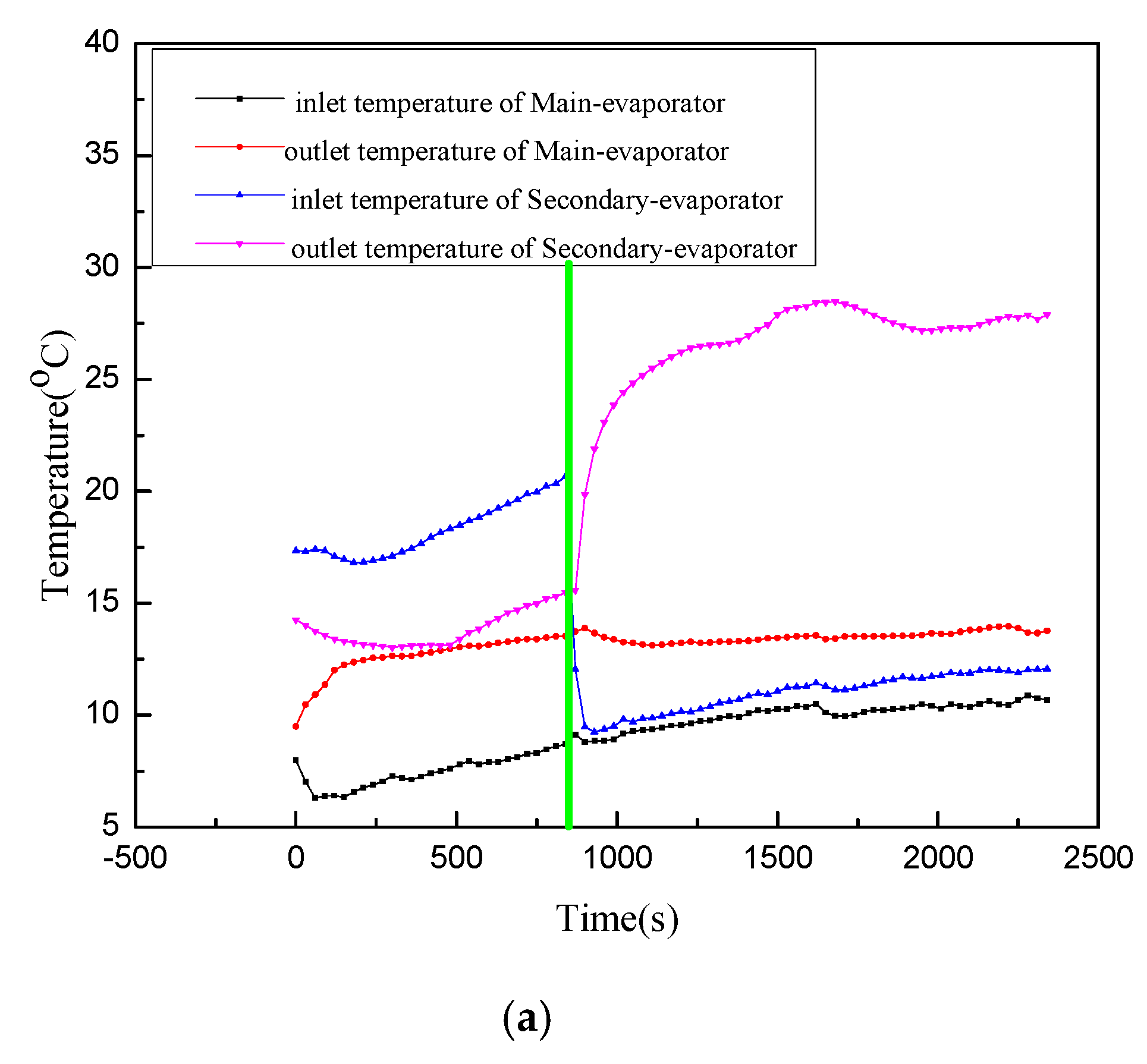
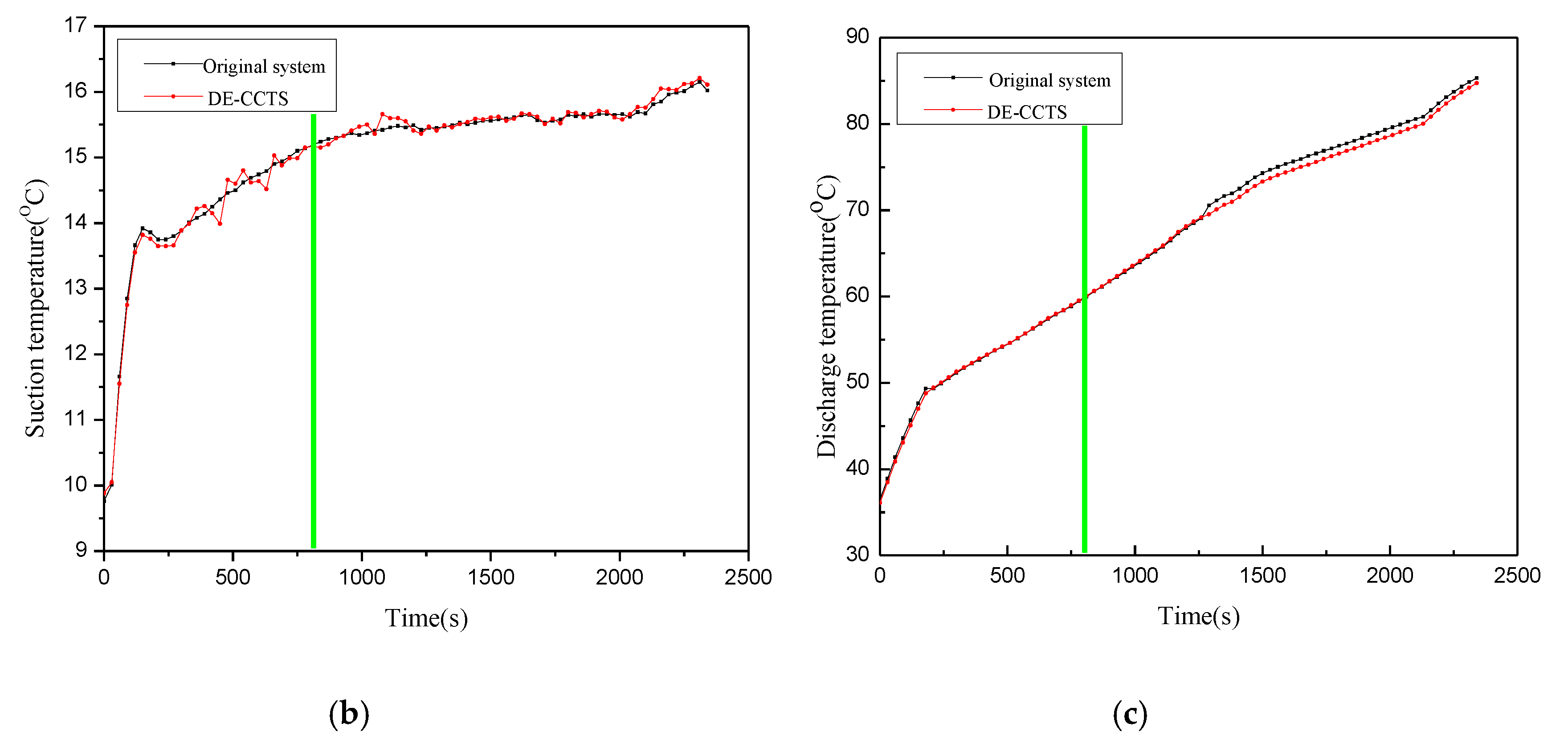
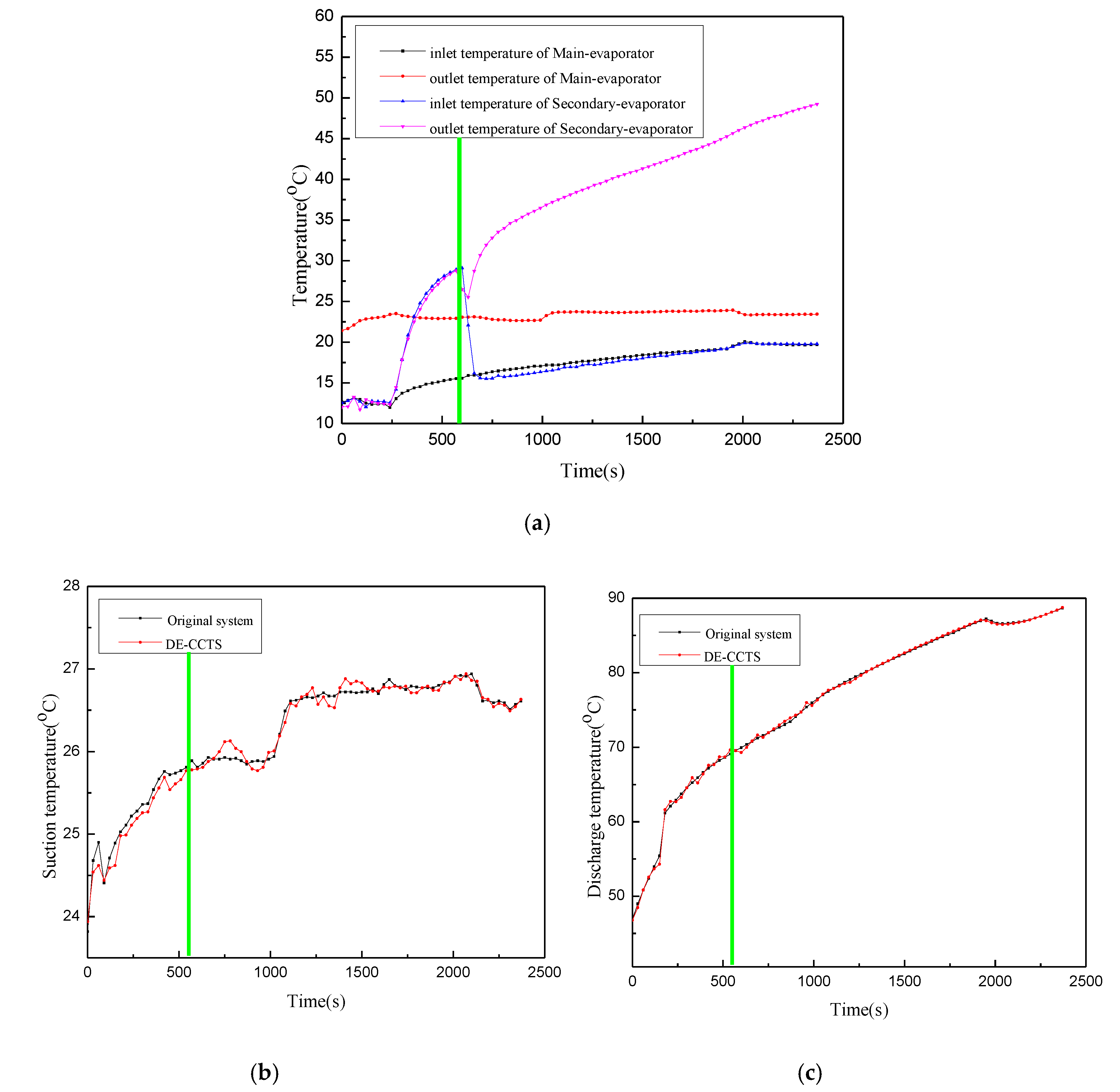
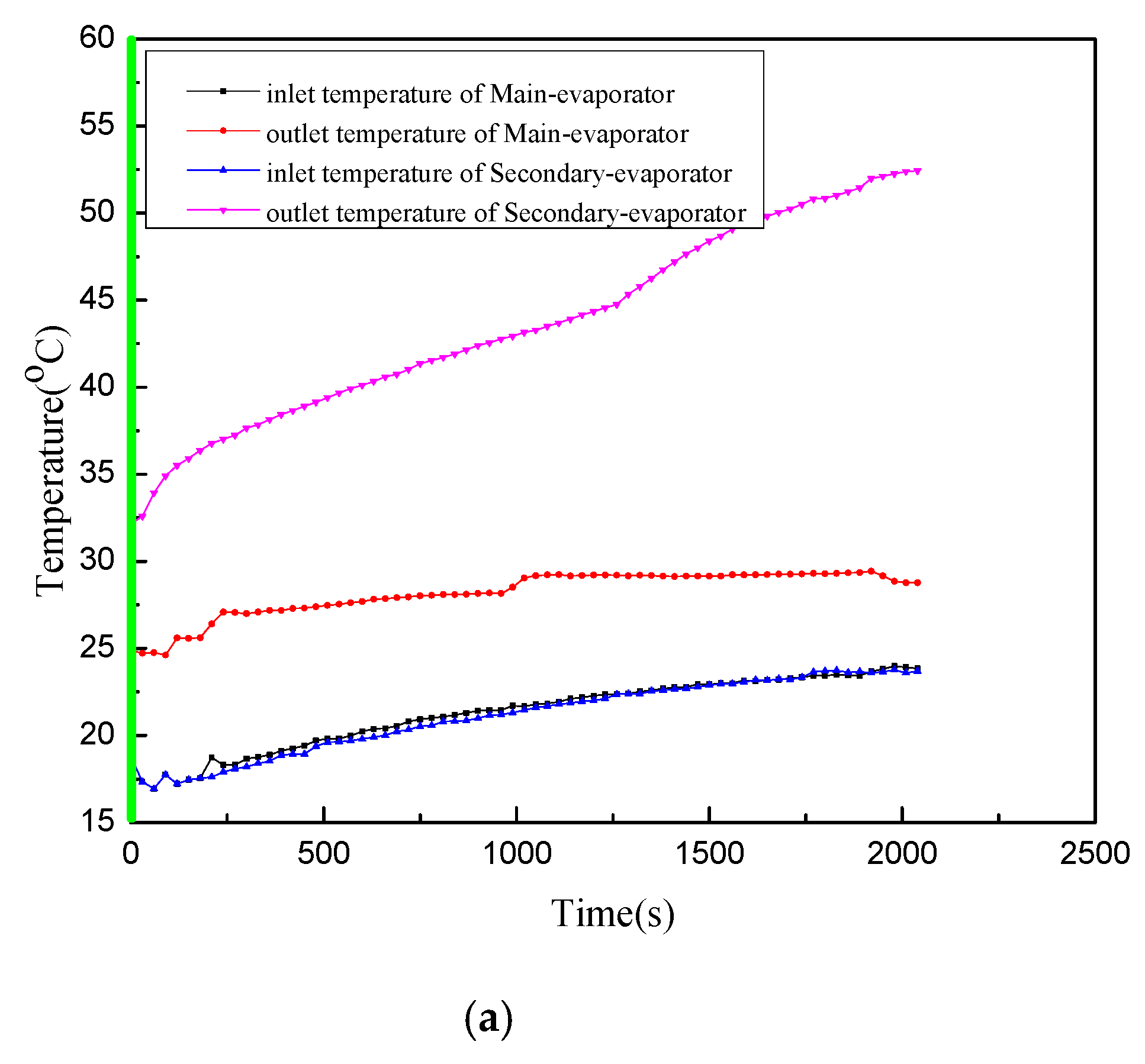

| Measurement Parameters | Instrument Type | Measuring Range | Accuracy |
|---|---|---|---|
| Temperature | Pt1000 | −50 °C to 400 °C | ±0.1 °C |
| Humidity | Humidity sensor | 0–100% | ±1% RH |
| Power meter | Lear PF9830 | 5–600 V/0.002–20 A | ±0.2% |
| Phase Change Material | Melting Point (°C) | Latent Heat of Dissolution (kJ/kg) | Thermal Conductivity (W/(m·K)) | Isobaric Heat Capacity (kJ/(kg·K)) | Density (kg/m3) |
|---|---|---|---|---|---|
| Paraffin wax | 45 | 178 | 0.151 | 2.12 | 732 |
| Temperature (°C) | −25 | −18 | −12 | −6 | 0 | 7 | 15 | 25 | 35 |
| Total Time (min) | 81 | 70 | 68 | 58 | 57 | 55 | 41 | 39 | 37 |
| Opening Time of Branch 1 (min) | 27 | 30 | 37 | 35 | 36 | 35 | 27 | 29 | 37 |
| Opening Time Proportion of Branch 1 (%) | 33.3 | 42.9 | 54.4 | 58.3 | 60.3 | 63.6 | 65.9 | 74.4 | 100 |
| Temperature (°C) | −25 | −18 | −12 | −6 | 0 | 7 | 15 | 25 | 35 |
| COP of the Original System | 1.23 | 1.25 | 1.27 | 1.45 | 1.61 | 1.71 | 2.87 | 3.50 | 4.25 |
| COP of the DE-CCTS | 1.27 | 1.28 | 1.33 | 1.51 | 1.67 | 1.75 | 2.90 | 3.53 | 4.25 |
| Percentage of COP Increase (%) | 3.25 | 2.4 | 4.72 | 4.14 | 3.73 | 2.34 | 1.06 | 0.85 | 0 |
© 2020 by the authors. Licensee MDPI, Basel, Switzerland. This article is an open access article distributed under the terms and conditions of the Creative Commons Attribution (CC BY) license (http://creativecommons.org/licenses/by/4.0/).
Share and Cite
Liu, Z.; Lou, F.; Qi, X.; Shen, Y. Enhancing Heating Performance of Low-Temperature Air Source Heat Pumps Using Compressor Casing Thermal Storage. Energies 2020, 13, 3269. https://doi.org/10.3390/en13123269
Liu Z, Lou F, Qi X, Shen Y. Enhancing Heating Performance of Low-Temperature Air Source Heat Pumps Using Compressor Casing Thermal Storage. Energies. 2020; 13(12):3269. https://doi.org/10.3390/en13123269
Chicago/Turabian StyleLiu, Zhongbao, Fengfei Lou, Xin Qi, and Yiyao Shen. 2020. "Enhancing Heating Performance of Low-Temperature Air Source Heat Pumps Using Compressor Casing Thermal Storage" Energies 13, no. 12: 3269. https://doi.org/10.3390/en13123269
APA StyleLiu, Z., Lou, F., Qi, X., & Shen, Y. (2020). Enhancing Heating Performance of Low-Temperature Air Source Heat Pumps Using Compressor Casing Thermal Storage. Energies, 13(12), 3269. https://doi.org/10.3390/en13123269





